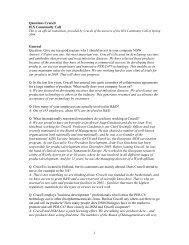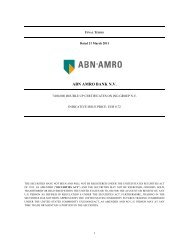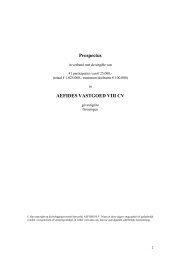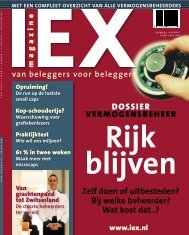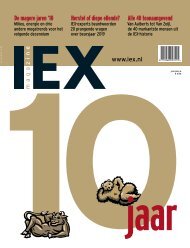Dit prospectus is gemaakt voor de uitgifte van dit product en ... - Iex
Dit prospectus is gemaakt voor de uitgifte van dit product en ... - Iex
Dit prospectus is gemaakt voor de uitgifte van dit product en ... - Iex
Create successful ePaper yourself
Turn your PDF publications into a flip-book with our unique Google optimized e-Paper software.
ERISA CONSIDERATIONSThe U.S. Employee Retirem<strong>en</strong>t Income Security Act of 1974, as am<strong>en</strong><strong>de</strong>d (“ERISA”), imposes requirem<strong>en</strong>tson employee b<strong>en</strong>efit plans (as <strong>de</strong>fined in Section 3(3) of ERISA) subject to ERISA and on <strong>en</strong>tities, such ascollective investm<strong>en</strong>t funds and separate accounts whose un<strong>de</strong>rlying assets inclu<strong>de</strong> the assets of such plans (allof which are hereinafter referred to as ERISA Plans), and on persons who are fiduciaries (as <strong>de</strong>fined in Section3(21) of ERISA) with respect to such ERISA Plans. The Co<strong>de</strong> also imposes certain requirem<strong>en</strong>ts on ERISAPlans and on other retirem<strong>en</strong>t plans and arrangem<strong>en</strong>ts, including individual retirem<strong>en</strong>t accounts and Keoghplans (such ERISA Plans and other “Plans” as <strong>de</strong>fined in Section 4975 of the Co<strong>de</strong> are hereinafter referred toas “Plans”). Certain employee b<strong>en</strong>efit plans, including governm<strong>en</strong>tal plans (as <strong>de</strong>fined in Section 3(32) ofERISA), certain church plans (as <strong>de</strong>fined in Section 3(33) of ERISA), and non-U.S. plans (as <strong>de</strong>scribed inSection 4(b)(4) of ERISA) are not subject to the prohibited transaction rules of ERISA or the Co<strong>de</strong> but may besubject to similar rules un<strong>de</strong>r other applicable laws or docum<strong>en</strong>ts. Accordingly, assets of such plans may beinvested in the Notes without regard to the prohibited transaction consi<strong>de</strong>rations un<strong>de</strong>r ERISA and the Co<strong>de</strong><strong>de</strong>scribed below, subject to the prov<strong>is</strong>ions of other applicable fe<strong>de</strong>ral, state or non-U.S. law (“Similar Law”).Investm<strong>en</strong>ts by ERISA Plans are subject to ERISA’s g<strong>en</strong>eral fiduciary requirem<strong>en</strong>ts, including therequirem<strong>en</strong>t of investm<strong>en</strong>t pru<strong>de</strong>nce and diversification, requirem<strong>en</strong>ts respecting <strong>de</strong>legation of investm<strong>en</strong>tauthority and the requirem<strong>en</strong>t that an ERISA Plan’s investm<strong>en</strong>ts be ma<strong>de</strong> in accordance with the docum<strong>en</strong>tsgoverning the ERISA Plan. Each ERISA Plan fiduciary, before <strong>de</strong>ciding to invest in the Notes, must besat<strong>is</strong>fied that investm<strong>en</strong>t in the Notes <strong>is</strong> a pru<strong>de</strong>nt investm<strong>en</strong>t for the ERISA Plan, that the investm<strong>en</strong>ts of theERISA Plan, including the investm<strong>en</strong>t in the Notes, are diversified so as to minim<strong>is</strong>e the r<strong>is</strong>k of large lossesand that an investm<strong>en</strong>t in the Notes complies with the ERISA Plan and related trust docum<strong>en</strong>ts.Section 406 of ERISA and/or Section 4975 of the Co<strong>de</strong> prohibits Plans from <strong>en</strong>gaging in certain transactionswith persons that are “parties in interest” un<strong>de</strong>r ERISA or “d<strong>is</strong>qualified persons” un<strong>de</strong>r the Co<strong>de</strong> with respectto such Plans (collectively, “Parties in Interest”). The types of transactions betwe<strong>en</strong> Plans and Parties inInterest that are prohibited inclu<strong>de</strong>: (a) sales, exchanges or leases of property, (b) loans or other ext<strong>en</strong>sions ofcre<strong>dit</strong> and (c) the furn<strong>is</strong>hing of goods and services. Certain Parties in Interest that participate in a non-exemptprohibited transaction may be subject to an exc<strong>is</strong>e tax un<strong>de</strong>r ERISA or the Co<strong>de</strong>. In ad<strong>dit</strong>ion, the personsinvolved in the prohibited transaction may have to rescind the transaction and pay an amount to the Plan forany losses real<strong>is</strong>ed by the Plan or profits real<strong>is</strong>ed by such persons and certain other liabilities could result thathave a significant adverse effect on such persons. Certain exemptions from the prohibited transactionprov<strong>is</strong>ions of Section 406 of ERISA and Section 4975 of the Co<strong>de</strong> may apply <strong>de</strong>p<strong>en</strong>ding in part on the type ofPlan fiduciary making the <strong>de</strong>c<strong>is</strong>ion to acquire a Note and the circumstances un<strong>de</strong>r which such <strong>de</strong>c<strong>is</strong>ion <strong>is</strong>ma<strong>de</strong>. Inclu<strong>de</strong>d among these exemptions are Section 408(b)(17) of ERISA (relating to certain transactionsbetwe<strong>en</strong> a plan and a non-fiduciary service provi<strong>de</strong>r), Prohibited Transaction Class Exemption (“PTCE”) 95-60 (relating to investm<strong>en</strong>ts by insurance company g<strong>en</strong>eral accounts), PTCE 91-38 (relating to investm<strong>en</strong>ts bybank collective investm<strong>en</strong>t funds), PTCE 84-14 (relating to transactions effected by a “qualified professionalasset manager”), PTCE 90-1 (relating to investm<strong>en</strong>ts by insurance company pooled separate accounts) andPTCE 96-23 (relating to transactions <strong>de</strong>termined by an in-house asset manager). There can be no assurancethat any of these class exemptions or any other exemption will be available with respect to any particulartransaction involving the Notes.Un<strong>de</strong>r a “look-through rule” set forth in regulations <strong>is</strong>sued by the U.S. Departm<strong>en</strong>t of Labor at 29 C.F.R.Section 2510.3-101, as modified by Section 3(42) of ERISA (“Plan Assets Regulation”), if a Plan invests inan “equity interest” of an <strong>en</strong>tity that <strong>is</strong> neither a “publicly-offered security” nor a security <strong>is</strong>sued by aninvestm<strong>en</strong>t company reg<strong>is</strong>tered un<strong>de</strong>r the Investm<strong>en</strong>t Company Act, the Plan’s assets inclu<strong>de</strong> both the equityinterest and an undivi<strong>de</strong>d interest in each of the <strong>en</strong>tity’s un<strong>de</strong>rlying assets, unless it <strong>is</strong> establ<strong>is</strong>hed that the<strong>en</strong>tity <strong>is</strong> an “operating company” or that equity participation in the <strong>en</strong>tity by “b<strong>en</strong>efit plan investors” <strong>is</strong> not“significant”. The Plan Assets Regulation <strong>de</strong>fines equity participation in an <strong>en</strong>tity by “b<strong>en</strong>efit plan investors”as “significant” if 25 per c<strong>en</strong>t. or more of the value of any class of equity interest in the <strong>en</strong>tity <strong>is</strong> held by340



